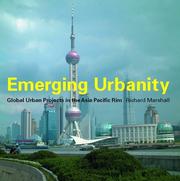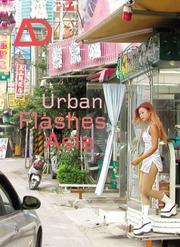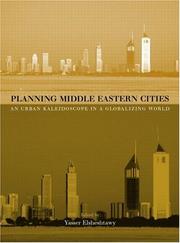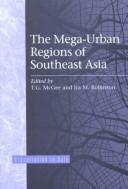| Listing 1 - 10 of 27 | << page >> |
Sort by
|
Dissertation
ISBN: 9789460189418 Year: 2014 Publisher: Leuven Katholieke Universiteit Leuven
Abstract | Keywords | Export | Availability | Bookmark
 Loading...
Loading...Choose an application
- Reference Manager
- EndNote
- RefWorks (Direct export to RefWorks)
The main research objective is to decipher the role of both water conditions and water conflicts in the interplay of the rural settlements and productive landscapes that constitute the Chia-Nan Plain, Taiwan. Consequently, the research considers Taiwans (r)urban design from three main perspectives: (1) rural water management; (2) vulnerable productive landscapes; and (3) fragmentated peri-urban settlements. The rural economies of Taiwan have been experiencing a shift from agriculture to high-technology industry, while the rural population remained stable and aging. Therefore, the research focuses on the challenges regarding the environmental and economic transformations of the rural areas in the Chia-Nan Plain. The research applies descriptive and interpretive mapping methodologies to review the patterns of interactions between cultivation behaviours and rural settlement morphologies in the Chia-Nan Plainthe rice basket of Taiwan. The research furthermore discusses the crucial logics behind the formation of settlements in this region as a result of rural-urban interactions. Hence, three layers (water, productive landscape, and scales of production) in the productive surface, that are critical to the spatial environment, are highlighted in the research. These three layers characterize its social and spatial networks for territorial development, and build up the fundamental structures and activities of the region. Three new hypotheses in the form of urban design investigations, are tested: (1) a qualitative water landscape which could guide the deurbanization in the post-agricultural regions; (2) a qualitative water productive landscape that could be an engine of new rural economic development; and (3) new scales of production which could change land patterns. The design research for the Chia-Nan plain concentrates mainly on the ability of the potential new rural settlement forms to adapt to the contemporary requirements that result from climate change and economic shifts. Extreme weather conditions, such as floods and droughts, are both new realities. The increasing frequency of storms has led to massive floods in both low-lying fields and along the coastline, and droughts have resulted in a fight of water usage between agriculture and high-technology industry. The research employs two case studies to discuss two different water-related productive landscapes (paddy and aquatic landscapes), and explores how innovative urban design propositions and water management measures in these territories can be adapted to benefit the environment. The areas investigated by these two case studies are located in two different geographical conditionsplain and coastal areasof the Chia-Nan Plain. They face two different challenges, namely water retention and land subsidence. The two case studies are initiated by historical analysis and the deciphering of contemporary projects, via-a-vis layered narratives and contested territories of specific sites. Design research concludes the two studies, that intend to innovate an approach for Taiwans urban design and water management in the interplay of rural settlements and productive landscapes. They verify the three hypotheses. In short, the research uses research by design. It explores spatial strategies that aim to have the potential to meet the changes of contemporary society and steer necessary environmental transformations. The research therefore draws on and contributes to the field of landscape urbanism in Asian agrarian territories, which are currently undergoing unprecedented transformation, in speed, scale and scope. The research will enable new possibilities for a productive terrain to generate new public realm, which can be used by urban and landscape designs to structure a deurbanizing agrarian territory.

ISBN: 0415256232 Year: 2003 Publisher: London Spon
Abstract | Keywords | Export | Availability | Bookmark
 Loading...
Loading...Choose an application
- Reference Manager
- EndNote
- RefWorks (Direct export to RefWorks)
Book
ISBN: 9789056828325 Year: 2007 Publisher: Leuven Katholieke Universiteit Leuven
Abstract | Keywords | Export | Availability | Bookmark
 Loading...
Loading...Choose an application
- Reference Manager
- EndNote
- RefWorks (Direct export to RefWorks)
City planning --- Urbanisme --- South Asia --- Asie méridionale --- History --- Histoire --- 711.4 <5> --- Gemeentelijke planologie. Stadsplanning. Stedenbouw--Azië --- 711.4 <5> Gemeentelijke planologie. Stadsplanning. Stedenbouw--Azië --- Asie méridionale
Book
ISBN: 9789056828301 Year: 2007 Publisher: Leuven Katholieke Universiteit Leuven
Abstract | Keywords | Export | Availability | Bookmark
 Loading...
Loading...Choose an application
- Reference Manager
- EndNote
- RefWorks (Direct export to RefWorks)
Book
ISBN: 9789056828318 Year: 2007 Publisher: Leuven : Katholieke Universiteit Leuven,
Abstract | Keywords | Export | Availability | Bookmark
 Loading...
Loading...Choose an application
- Reference Manager
- EndNote
- RefWorks (Direct export to RefWorks)
City planning --- Urbanisme --- Karachi (Pakistan) --- Description and travel --- Descriptions et voyages --- Academic collection --- 711.4 <5> --- Gemeentelijke planologie. Stadsplanning. Stedenbouw--Azië --- 711.4 <5> Gemeentelijke planologie. Stadsplanning. Stedenbouw--Azië --- Karāchi (Pākistān)
Book
ISBN: 2853191176 Year: 1984 Publisher: Paris : Editions CILF - Conseil International de la Langue Française, Institut international d'architecture méditérranéenne,
Abstract | Keywords | Export | Availability | Bookmark
 Loading...
Loading...Choose an application
- Reference Manager
- EndNote
- RefWorks (Direct export to RefWorks)
711.4 <5> --- Gemeentelijke planologie. Stadsplanning. Stedenbouw--Azië --- 711.4 <5> Gemeentelijke planologie. Stadsplanning. Stedenbouw--Azië --- City planning. --- Urbanization. --- Géographie urbaine --- Moslem architecture --- History --- Community development --- Geographie zonale --- Islam
Book
ISBN: 9781951541323 1951541324 Year: 2021 Publisher: Novato ORO Editions
Abstract | Keywords | Export | Availability | Bookmark
 Loading...
Loading...Choose an application
- Reference Manager
- EndNote
- RefWorks (Direct export to RefWorks)
This book examines the urban fabric of contemporary Tokyo as a valuable demonstration of permeable, inclusive, and adaptive urban patterns that required neither extensive master planning nor corporate urbanism to develop. These urban patterns are emergent: that is, they are the combined result of numerous modifications and appropriations of space by small agents interacting within a broader socio-economic ecosystem. Together, they create a degree of urban intensity and liveliness that is the envy of the world’s cities.This book examines five of these patterns that appear conspicuously throughout Tokyo: yokochō alleyways, multi-tenant zakkyo buildings, undertrack infills, low-rise dense neighborhoods, and the river-like ankyo streets. Unlike many of the discussions on Tokyo that emphasize cultural uniqueness, this book aims at transcultural validity, with a focus on empirical analysis of the spatial and social conditions that allow these patterns to emerge. The authors of Emergent Tokyo acknowledge the distinct character of Tokyo without essentializing or fetishizing it, offering visitors, architects, and urban policy practitioners an unparalleled understanding of Tokyo’s urban landscape.
711.4 <5> --- 711.4 <5> Gemeentelijke planologie. Stadsplanning. Stedenbouw--Azië --- Gemeentelijke planologie. Stadsplanning. Stedenbouw--Azië --- City planning --- Cities and towns --- Urbanisme --- Villes --- Social aspects --- Aspect social --- Tokyo (Japan) --- Tokyo (Japon) --- Social conditions. --- Conditions sociales

Abstract | Keywords | Export | Availability | Bookmark
 Loading...
Loading...Choose an application
- Reference Manager
- EndNote
- RefWorks (Direct export to RefWorks)
This book is a bold conceptual and architectural response to the contemporary city. Supplanting recent western accounts of urban developments, centred largely on European research, it introduces an emergent network of globally dispersed architects, theorists and urbanists. Working primarily, though not exclusively, out of Asia, the contributors are a globally active body that is fast developing a rapidly evolving language of urban imagination and intervention. This is a new and intriguing version of events, which is wholly in the step with the simultaneous and spontaneous nature of urban developments in Asia, as China and much of the surrounding region come alive. It features an interview with the Japanese master Kazuo Shinohara and a practice profile of pioneering Chinese architecture Yung Ho Chang.
711.4 <5> --- 72.036 <5> --- 72.036 <5> Moderne bouwkunst. Architectuur van de 20e eeuw--Azië --- Moderne bouwkunst. Architectuur van de 20e eeuw--Azië --- 711.4 <5> Gemeentelijke planologie. Stadsplanning. Stedenbouw--Azië --- Gemeentelijke planologie. Stadsplanning. Stedenbouw--Azië --- Environmental planning --- Architecture --- urban development --- Asia --- Cities and towns --- Villes --- Growth. --- History --- Croissance --- Histoire

ISBN: 0203355601 1134410107 1280078537 020360900X 9780203609002 9780415304009 0415304008 9786610078530 661007853X 0415304008 9780203355602 9781134410101 9781280078538 9781134410057 9781134410095 9780415553094 1134410093 Year: 2004 Publisher: London ; New York : Routledge,
Abstract | Keywords | Export | Availability | Bookmark
 Loading...
Loading...Choose an application
- Reference Manager
- EndNote
- RefWorks (Direct export to RefWorks)
Middle Eastern cities cannot be lumped together as a single group. Rather they make up the urban kaleidoscope of the title, as the diversity of the six cities included here shows. They range from cities rich in tradition (Cairo, Tunis, and Baghdad), to neglected cities (Algiers and Sana'a), to newly emerging 'oil-rich' Gulf cities (Dubai). The authors are all young Arab scholars and architects local to the cities they describe, providing an authentic voice with an understanding no outsider could achieve. These contributors move away from an exclusively 'Islamic' reading of A
City planning --- Cities and towns --- Civic planning --- Land use, Urban --- Model cities --- Redevelopment, Urban --- Slum clearance --- Town planning --- Urban design --- Urban development --- Urban planning --- Land use --- Planning --- Art, Municipal --- Civic improvement --- Regional planning --- Urban policy --- Urban renewal --- Government policy --- Management --- 711.4 <5> --- 711.4 <5> Gemeentelijke planologie. Stadsplanning. Stedenbouw--Azië --- Gemeentelijke planologie. Stadsplanning. Stedenbouw--Azië

ISBN: 0774805307 077480548X 9780774805483 Year: 1995 Publisher: Vancouver UBC press
Abstract | Keywords | Export | Availability | Bookmark
 Loading...
Loading...Choose an application
- Reference Manager
- EndNote
- RefWorks (Direct export to RefWorks)
711.4 <5> --- 711.432 --- Urbanization --- Metropolitan areas --- Regional planning --- Regional development --- State planning --- Human settlements --- Land use --- Planning --- City planning --- Landscape protection --- Conurbations --- MAs (Metropolitan areas) --- Metropolitan statistical areas --- Urban areas --- 711.432 Planologie: hoofdsteden; wereldsteden; metropolen --- Planologie: hoofdsteden; wereldsteden; metropolen --- 711.4 <5> Gemeentelijke planologie. Stadsplanning. Stedenbouw--Azië --- Gemeentelijke planologie. Stadsplanning. Stedenbouw--Azië --- Government policy --- Urbanisation --- Agglomérations urbaines --- Southeast Asia --- Asie du Sud-Est --- Social conditions. --- Conditions sociales
| Listing 1 - 10 of 27 | << page >> |
Sort by
|

 Search
Search Feedback
Feedback About UniCat
About UniCat  Help
Help News
News